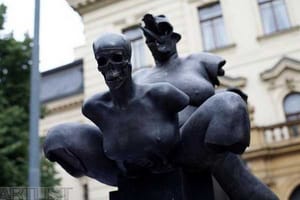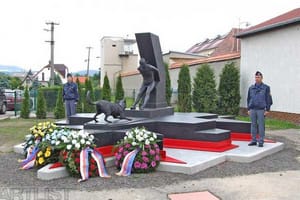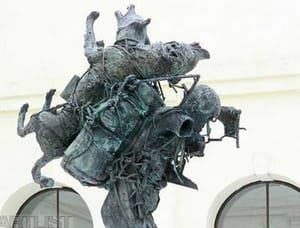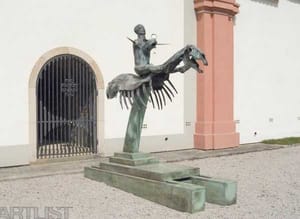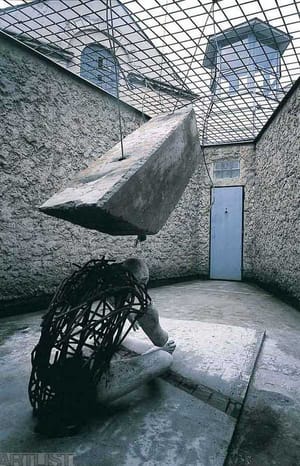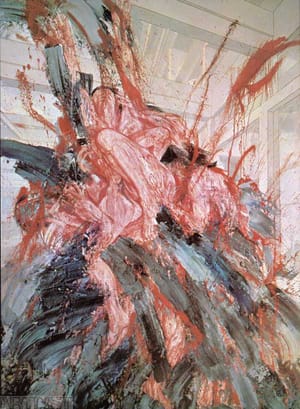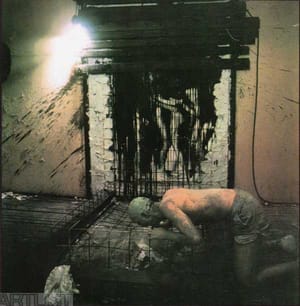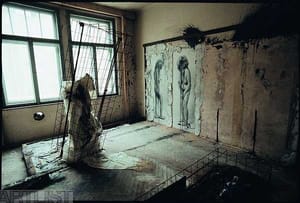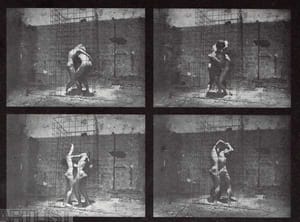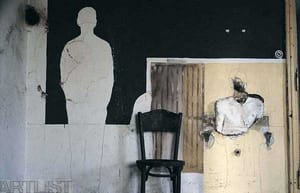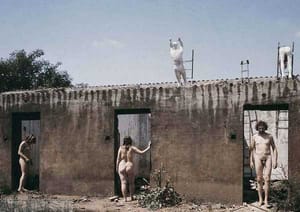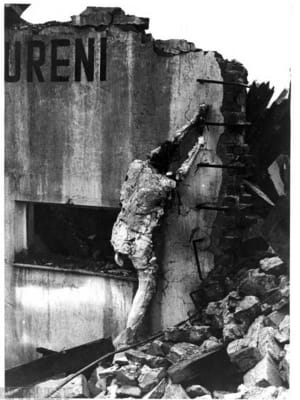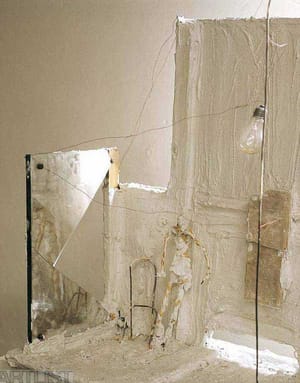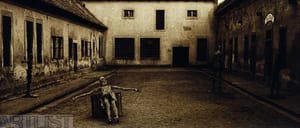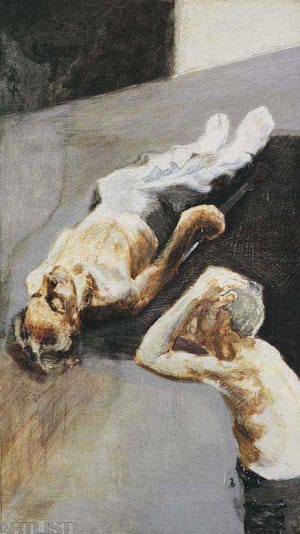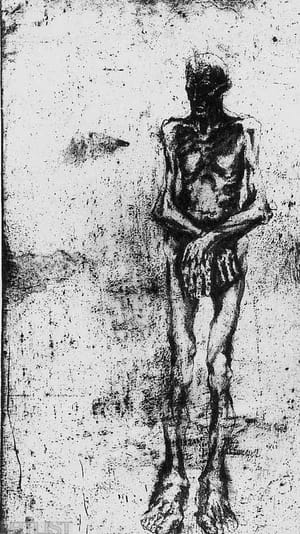- First Name
- Jiří
- Surname
- Sozanský
- Born
- 1946
- Birth place
- Prague
- Place of work
- Prague
- Website
- http://www.sozansky.info
- CSU Library
- ↳ Find in the catalogue
About artist
Jiří Sozanský graduated from the Academy of Fine Arts in Prague in 1973. This was a difficult period in all sorts of ways. Sozanský found it difficult to reconcile himself with the lack of freedom of the normalisation period, which prevented any open dialogue or contact with the world. In addition, the 1970s generation was finding it difficult to create a distinctive style. After the fertile 1960s, which introduced many new trends onto the art scene, it was difficult to find a path that did not simply imitate what had gone before. Though he was both a painter and draftsman, Sozanský was to find an outlet for his personal feelings in environmental actions.
The whole of Sozanský’s oeuvre is characterised by an engagement against different forms of social violence and ideological diktat that undermine human rights and the dignity of Man. As a result, his work captures Man in marginal situations and depicts human trauma provoked by a dramatic turn of events or the violence of official power. This is present in the graphic cycle Job, which he began working on while still a student in 1970-71. This cycle shows Sozanský to be an artist for whom the figure is the main theme.
In the late 1970s, Sozanský discovered a new possibility in environmental events. His first such event was held in Terezín. The artist reacted to the concentration camp in Small Fortress (1976). He began to create expressive sculptures betraying traces of the inspiration of the work of Olbram Zoubek, with whom Sozanský worked briefly. He placed his sculptures in the austere prison cells and grey courtyards of the fortress. The environmental images he created in Terezín became a timeless symbol of those tragic moments in human history in which Man is cast into a state of torment through the power of despotism.
Since then Sozanský’s work has been characterised by a combination of various artistic methods. He responded to his experience in Terezín with paintings and drawings, and these became an ongoing part of his work alongside the environment and sculpture. An innovation came in the form of Models of Extreme Situations (1979), in which the artist moved away from classical sculpture. These are constructions created from metal and plaster representing a kind of semi-demolished space in which small human figures are situated. The existential resonance of these situations expanded the intensity of the artist’s work, which has become an ongoing seismograph of the conflict of Man with civilisation that does not always conduct itself humanistically.
Sozanský returned to Terezín once more in 1980, this time inviting Zdeněk Beran and Ivan Bukovský to participate in expressing their opinion in art that should above all contain a message and represent a testimony of the world. Another of his events followed the same direction, this time in the deserted buildings of the old part of the City of Most, intended for demolition in order to make way for new mining concessions. The derelict building because the subject of the artist’s interest in the environmental event House No. 50, 1987. This also involved a collaboration, this time with an actor who read out the story of Job in the deserted premises, creating a moving performance captured in many sequential photographs.
The situation following the Velvet Revolution allowed Sozanský to work on the preparation of similar projects on a professional level with international participation. He and his wife set up a civic association, which organised symposia in collaboration with the Gallery of Fine Art in Litoměřice at what used to be the Jesuit baroque church (Sozanský has always loved the baroque). The church was the venue for international meetings (The Baroque and the Present Day, 1992, Open Dialogue, 1994).
Another impulse behind Sozanský’s output were the atrocities taking place in the former Yugoslavia. Sozanský became involved in the struggle over the territory and experienced this extreme situation for himself. The result was an event that took aim against buck-passing indifference and sought support for the suffering of Bosnia and Herzegovina. Sozanský was also moved by the events of 9/11 to paint the cycle called Ground Zero.
The whole of Sozanský’s output is infused with an artistic reflection upon the life of people in critical situations. It can take the form of environment, painting, sculpture, drawing or graphic art. Many events, some on the frontier of happening, were one-off in character and preserved only in photographs and video recordings. Sozanský’s starting point was concrete politically motivated events. However, his work is a generally valid cautionary memento of global civilisation in these widest of contexts.
- Author of the annotation
- Ivona Raimanová
CV
Studies:
1967-1973 Academy of Fine Arts Prague, F. Jiroudek
Awards:
2016 Paul Faiereisl price Memory Fragments
2016 title Knight of Czech Culture, awarded by the Minister of Culture
2007 Medaile za dlouholetou spolupráci s Památníkem Terezín
1995 Čestné uznání International Peace Centre, Sarajevo
1971 Cena 17. listopadu, Akademie výtvarných umění v Praze
Stipends:
1995 Grant Nadace Open Society Fund Praha
1988 Stipendium Jackson-Pollock Krasner Foundation New York
2015 scholarship by the Ministry of Culture for the project MEMORIALS
Exhibitions
- Solo exhibitions
-
2011
Metropolis, Muzeum hlavního města Prahy, Praha
2010
Skelety, Museum Kampa, Praha
Den dvacátý sedmý / Day Twenty Seven, Muzeum policie České republiky, Praha
2009
Outsideři, Galerie Jiřího Jílka, Šumperk
Sutiny, Obecní dům, Praha
Jiří Sozanský, Muzeum policie České republiky, Praha
2006
Grafika, Galerie Magna, Ostrava
2005
Téma Job, Severočeská galerie výtvarného umění v Litoměřicích, Litoměřice
Z prachu a popele - koláže, grafiky, Staroměstská radnice, Křížová chodba, Praha
2001
Kámen a kost / The Stone and Bone, Symposion, _
Kresby a grafika / Drawings & prints, Galerie Millennium, Praha
Pocta Janu Zahradníčkovi, Galerie Hollar, Praha
1999
K pramenům inspirace / Toward the sources of inspiration, E galerie, Žirovnice (Pelhřimov)
K pramenům inspirace / Toward the sources of inspiration, Šternberský palác, Praha
Kresby, kvaše, grafika, Galerie Millennium, Praha
Téma Bible, Galerie Litera, Praha
1991
Obrazy, Galerie Nová síň, Praha
Kresby, Galerie Litera, Praha
1990
Zpráva ze 3. oddělení, Věznice Valdice, Valdice
1989
1970 - 1989, Lidový dům, Praha
1987
Kresby, Dům kultury, Malá scéna, České Budějovice
1986
Jiří Sozanský, Galerie Opatov, Praha
Kresby, Galerie Na bidýlku, Brno
1985
Kresby, Oblastní galerie v Liberci, Liberec
- Group exhibitions not included in ARTLIST.
-
2012
Ekecheiriá: Vzpomínky na Olympii. Pocta olympijské tradici, Muzeum hlavního města Prahy, Praha
Od Tiziana po Warhola: Muzeum umění Olomouc 1951-2011 (IV. Výtvarné umění 1948-2011), Trojlodí, Olomouc
2011
50/2: Padesát autorů českého grafického umění 2. poloviny 20. století ze sbírek galerie, Letohrádek Ostrov, Ostrov (Karlovy Vary)
2009
Jan Palach: 16. - 25.1. 1969, Pražský dům fotografie (Prague House of Photography, o.p.s - PHP), Praha
...ze sbírky II. Člověk ve 20. století, Galerie umění Karlovy Vary, Karlovy
2008
Koloseum - Vítězové a poražení, Mánes, Praha
Nechci v kleci! / No cage for me!, Muzeum umění Olomouc
Vítězové, La Fabrika, Praha
2007
Od sochy ... České sochařství 2. poloviny 20. století ze sbírek Galerie Klatovy / Klenová, Galerie U Bílého jednorožce, Klatovy
České umění XX. století: 1970-2007, Alšova jihočeská galerie v Hluboké nad Vltavou, Hluboká nad Vltavou
5 let po povodni, Galerie Millennium, Praha
2006
Podvědomí, Galerie Millennium, Praha
Kalendáře pro Jindru Štreita, Dům umění, přednáškový sál, Ostrava
Monstra a monstra v nás, Galerie Millennium, Praha
His Master's Freud, Galerie Mona Lisa, Olomouc
Svět české grafiky, Zámek Bruntál, Bruntál
2005
Exprese / Expressiveness, České muzeum výtvarných umění, výstavní prostory, Praha
2003
Art Prague. 2. veletrh současného umění / 2th Contemporary Art Fair, Praha
2002
Duchovní rozměr grafiky, Sdružení českých umělců grafiků Hollar, Praha
Mánes ve mlýnici, Löwitův mlýn, Praha
2001
Možnosti proměny I, Galerie Františka Drtikola, Příbram
...o lidech..., České muzeum výtvarných umění, Galerie Bayer & Bayer, Praha
2000
Současná minulost. Česká postmoderní moderna 1960-2000, Alšova jihočeská galerie v Hluboké nad Vltavou, Hluboká nad Vltavou
Dva konce století 1900 2000, Dům U Černé Matky Boží, Praha
Práce s tělem - trojí verze zápasu, Mánes, horní sál, Praha
1999
Eros v evropské grafice v průběhu staletí, Galerie Hollar, Praha
Obraz, socha a svět, Mánes, Praha
1997
Novozákonní motivy v Českém umění 20. století, Galerie umění Karlovy Vary
Umění zastaveného času / Art when time stood still, Česká výtvarná scéna 1969-1985, Brno
Mezi tradicí a experimentem. Práce na papíře a s papírem v českém výtvarném umění 1939-1989, Trojlodí, Olomouc
Umění zastaveného času / Art when time stood still, Česká výtvarná scéna 1969-1985, Státní galerie výtvarného umění v Chebu, Cheb
Furia della figura, Galerie Hollar, Praha
Proměny krajiny v českém malířství 20. století, Veletržní palác, Praha
1996
I. nový zlínský salon, Zlín,
Theatrum mundi. Figurální grafika, Galerie Hollar, Praha
Novozákonní motivy v Českém umění 20. století, Galerie moderního umění v Roudnici nad Labem, Roudnice nad Labem
Umění zastaveného času / Art when time stood still, Česká výtvarná scéna 1969-1985, Praha
Zpřítomnění, Přírůstky galerie z let 1987 - 1994, Zámek Klenová, Klenová (Klatovy)
1995
Kresba nebo obraz?, Palác Kinských, Praha
Starozákonní motivy v českém umění dvacátého století, Galerie moderního umění v Roudnici nad Labem, Roudnice nad Labem
1993
Inter - Kontakt - Grafik - Praha ´93, Mánes, Praha
Záznam nejrozmanitějších faktorů… České malířství 2. poloviny 20. století ze sbírek státních galerií, Jízdárna Pražského hradu, Praha
1992
Minisalon, Galerie Nová síň, Praha
Situace 92, Mánes, Praha
Přírůstky českého umění 20. století z let 1989-1992, Jízdárna Pražského hradu, Praha
Členská výstava Spolku výtvarných umělců Mánes, Mánes, Praha
1991
Šedá cihla 78/1991, Dům umění města Opavy, Opava
Prostor Zlín ´91, Zlín, exteriéry města, Zlín
Šedá cihla 78/1991, Zámek Klenová, Klenová (Klatovy)
Umění akce, Mánes, Praha
Proti zdi, Galerie Fronta, Praha 2
1990
Dialog ´90, Mánes, Praha
Obrazy a plastiky, Věznice Valdice, Valdice
Pocta umělců Jindřichovi Chalupeckému, Městská knihovna, Praha
Polymorphie: Kunst als subversives Element Tschechoslowakei 1939-1990, Martin-Gropius-Bau, Berlín
Člověk v obraze, Středočeská galerie, výstavní síně, Praha
Tshekkiläistä nykytaidetta, Helsingin kaupungin taidemuseo, Helsinky
1989
Střední věk, Dům U Kamenného zvonu, Praha
1988
Barevná plastika, Vojanovy sady, Praha
Hugo Demartini: Objekty, Jiří Sozanský: Obrazy, Lidový dům, Praha
Forum 1988, Holešovická tržnice, Praha
1987
Rockfest 87, Palác kultury, Praha
30 výtvarníků v Lidovém domě, Lidový dům, Praha
1986
České umění 20. století, Alšova jihočeská galerie v Hluboké nad Vltavou, Hluboká nad Vltavou
Zuzana Nováčková: Grafika, Jiří Sozanský: Kresby, Galerie d, Praha
1984
Česká kresba 20. století ze sbírek Alšovy jihočeské galerie, Alšova jihočeská galerie v Hluboké nad Vltavou, Hluboká nad Vltavou
1983
Obrazy a sochy, Obvodní kulturní dům Gong, Praha
Člověk a svět. Mladá figurální tvorba, Oblastní galerie v Liberci, Liberec
Motiv okna v díle deseti současných českých výtvarných umělců, Letohrádek Ostrov, Ostrov (Karlovy Vary)
Nové kresby, Výběr z přírůstků 1973-1983, Letohrádek Ostrov, Ostrov (Karlovy Vary)
Prostor, architektura, výtvarné umění, Výstaviště Černá Louka, Ostrava
1982
Práce architektů, malířů a sochařů, Ústav makromolekulární chemie, výstavní síň, Praha
1981
České malířství a sochařství 1900 - 1980, Alšova jihočeská galerie v Hluboké nad Vltavou, Hluboká nad Vltavou
Bláha, Novák, Ouhel, Pavlík, Rittstein, Sozanský: Obrazy (Absolventi AVU z let 1973-1974), Galerie umění Karlovy Vary, Karlovy Vary
Karel Pauzer: Sochy, Jiří Načeradský: Obrazy, Jiří Sozanský: Grafiky, Regionální muzeum Kolín, Kolín
Sochy a objekty na malostranských dvorcích, Malá Strana, Praha
1980
Terezín '80, Památník Terezín, Terezín
1979
České umění 1945/1975, Alšova jihočeská galerie v Hluboké nad Vltavou, Hluboká nad Vltavou
1978
Konfrontace, Mikrobiologický ústav ČSAV, Praha
1977
Česká protiválečná grafika 1940-1975, Galerie výtvarného umění, Roudnice nad Labem
1975
České výtvarné umění v boji proti fašismu a válce, Malá pevnost, Terezín
- Collections
-
Národní galerie v Praze
Památník Terezín
Alšova jihočeská galerie v Hluboké nad Vltavou
České muzeum výtvarných umění Praha
Oblastní galerie v Liberci
Galerie Benedikta Rejta Louny
Severočeská galerie výtvarného umění v Litoměřicích
Galerie moderního umění v Roudnici nad Labem
Galerie umění Karlovy Vary
Galerie výtvarného umění Klenová
Moravská galerie v Brně
Musée national d'art moderne Paris
Centre Georges Pompidou Paris
Musée Saint Denis Paris
Musée d'art moderne de la Ville de Paris
Helsinki Kaupungin Taidemuseo Helsinki
National Gallery Sarajevo
Museum Kampa
private collections
- Other realisations
Action / Environment
Akce (environmentální instalace)
2003
Karlín - Zóna A, Praha
1994
Otevřený dialog, Kostel Zvěstování Panny Marie, Litoměřice
1992
Barok a dnešek, Kostel Zvěstování Panny Marie, Litoměřice
1990
Pocta Janu Zahradníčkovi, věznice Valdice
1987
Dům číslo 50, Galerie 55, Kladno
1983-1984
Veletržní palác, Praha
1981
Most 81/82, Most, Most
1980
Pevnost, Soukromé sympozium v Malé Pevnosti v Terezíně, Malá pevnost, Terezín
Beran, Bukovský, Dolejšek, Janečka, Kovář, Kulhánek, Sozanský, Památník Terezín, Terezín
1976
Památník Terezín, Terezín
Architecture and Public spaces:
2010
Mater Mortis, Úřad vlády České republiky, Praha
2009
Spojenci,Vrchní soud, Praha
Nový Památník obětem komunismu,Věznice Valdice
Šedesátý devátý , Galerie hlavního města Prahy, Trojský zámek
2008
Strážce, Nejvyšší kontrolní úřad ČR, Praha
2007
Památník obětem komunismu, Památník Vojna u Příbrami
Ukřižovaný II., kostel sv. Anny Jablonec nad Nisou
2006
Apokalyptický jezdec, Galerie hlavního města Prahy, Trojský zámek
Ukřižovaný I., Severočeská galerie výtvarného umění v Litoměřicích
1992
Memento mori,Terezín, důl Richard
1990
Památník obětem komunismu, Věznice Valdice
Monography
- Monography
Jiří Sozanský, Zóna, Nakladatelství Kant, Praha 2013
Jiří Sozanský, Sutiny (plastiky, grafiky, obrazy, koláže), katalog k výstavě v Obecním domě v Praze 2009, (text Brabec,J. a kol.), 54s., Symposion, Praha 2009
J.Sozanský a kol, Jiří Sozanský: Monology 1971-2006, Prostor, 214s., Praha 2006
I.Málková, J.Sozanský, Hledání Viléma Závady, Votobia, 286s., Praha 2003
J.Sozanský, K pramenům inspirace, Národní galerie v Praze, 40s.), 2000
Jiří Sozanský 1970-1989, katalog k výstavě v Lidovém domě, Praha-Vysočany, ONV Praha 9, 1989
